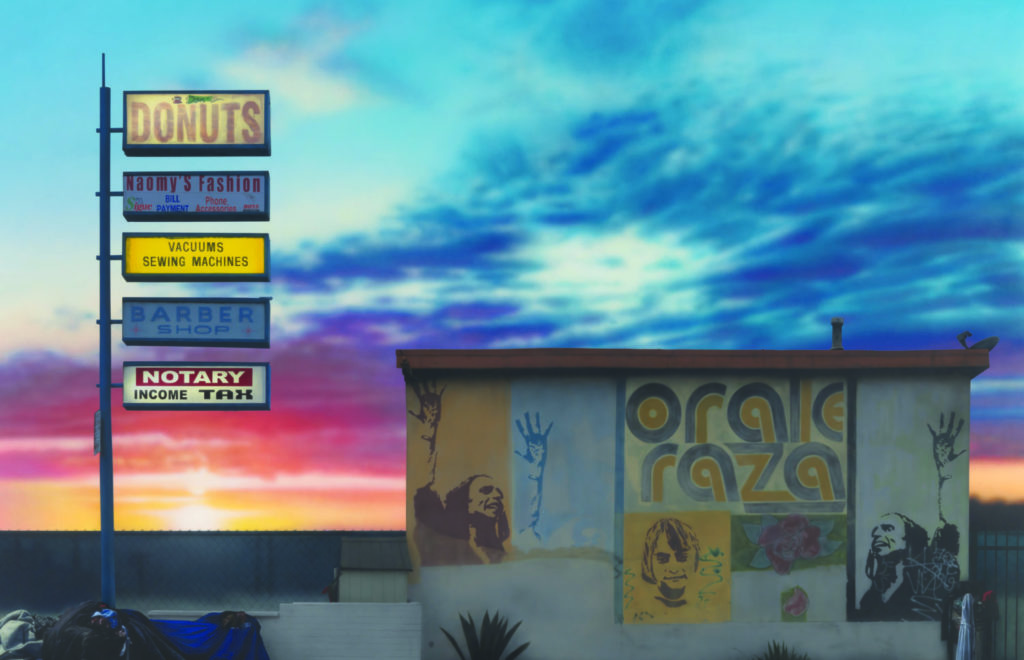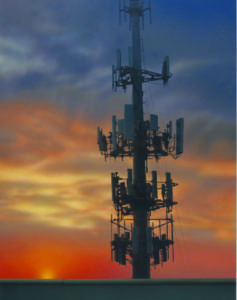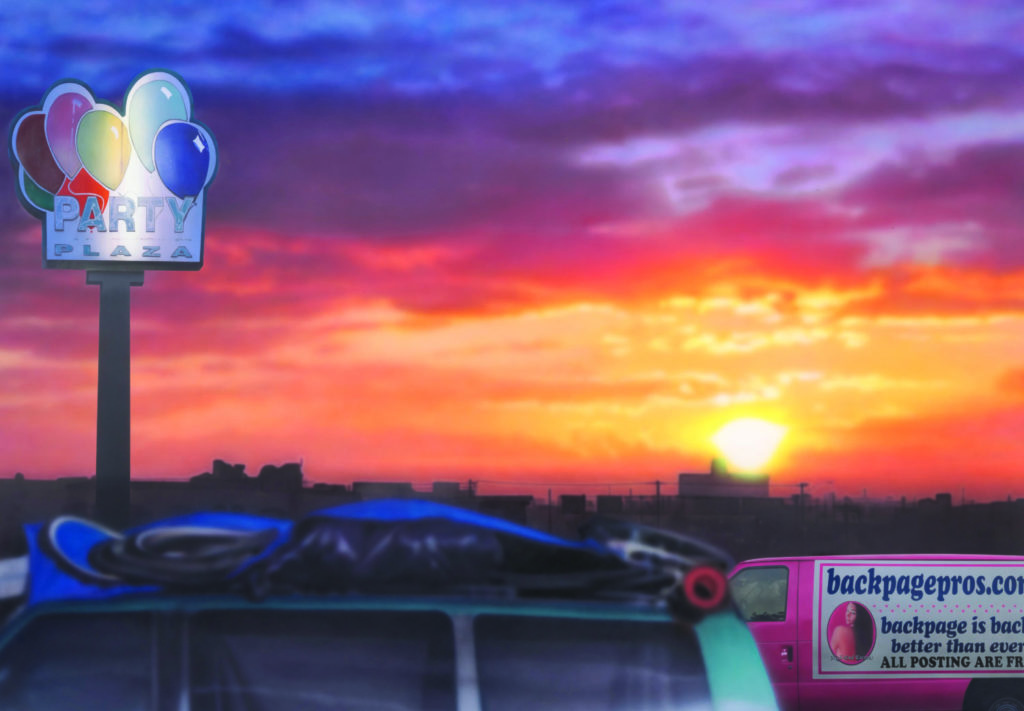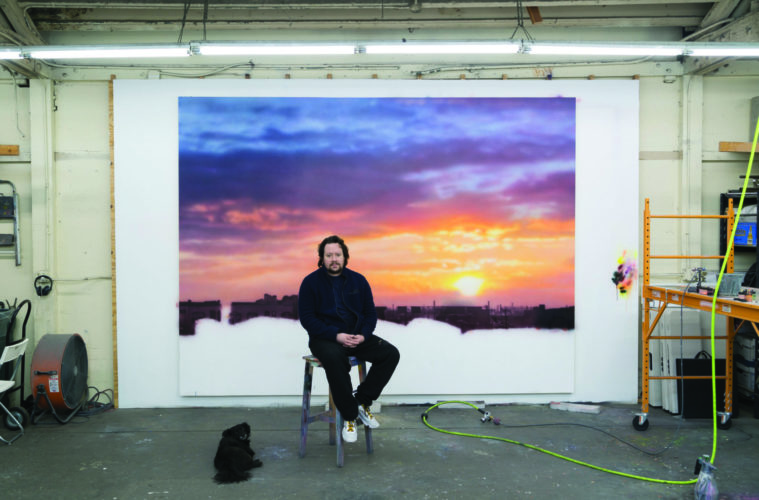“I’ve been feeling a need to be more present, not necessarily more political, but more rooted in reality,” says Sayre Gomez, sitting in his 3,000-square-foot studio bordering East L.A. — formerly a sewing shop where Ed Hardy gear was bedazzled — on a brisk morning in January. Dressed in a navy zip fleece, black sweatpants and bulky Nike trainers, the Chicago-born, L.A.-based artist is running on a lot of coffee and very little sleep. The night before, Gomez and his wife, Emmy Eves, welcomed their firstborn son, Desmond, to their Atwater Village home.
“On one hand, I’m totally overjoyed,” explains Gomez. “And then, on the other, I’m like, ‘What kind of world am I bringing my child into?’”
The answer, it would seem, is contained in the paintings hanging in various states of progress around the studio. Since the election of Donald Trump, the 37-year-old Gomez has been busy translating the image-saturated surrealism of our brave new world into what he broadly refers to as X-Scapes. These semi-fictionalized, photo-realistic tableaux capture those liminal spaces you only see in a haze while driving — L.A.’s de rigueur mode of travel — through the uncanny valley that is this 21st-century metropole.
From the motorist’s perspective there is a flattening of architecture, of infrastructure, one that mimics the way the internet flattens culture into a single algorithm. In a car everything in L.A. appears to blur, to merge: FYC billboards in Hollywood; maximalist Koreatown strip-mall kiosks; burgeoning battalions of construction cranes rising over downtown; and the endless flanks of homeless encampments providing a devastating connective tissue between it all.

Sayre Gomez, Open, 2019, acrylic on canvas. Courtesy of the artist and François Ghebaly, Los Angeles (Photo by Robert Wedemeyer)
Gomez’s X-Scapes force viewers to sit, to ponder every facet of the inconvenient (or unattractive) spaces we leave in our rearview mirror. Each of them depicts a hyper-articulated, if hybridized, vision of the city viewed in soft (and sharp) focus through the lens of sticker-collaged convenience-store doors, rusted chain-link fencing, graffiti-tagged car parks and cinematic rooftop vistas. At their best, these pictures hover somewhere between the Suprematist geometries of smart advertising, street art, the formal organization of Ed Ruscha’s early cityscapes, the relentlessly rendered vistas of Pictures Generation star Jack Goldstein, and the emotional realism of Gerhard Richter’s candle paintings.
“A lot of my most recent work assumes the point of view of someone who didn’t grow up here,” says Gomez, who still keeps a Bears jersey and Cubs memorabilia on the shelves of his studio library. “I definitely look at California or L.A. through a certain lens of exoticism. It’s super different from where I grew up, and so the promise of L.A. is super important. It’s such a weird place because it’s fake and really real at the same time, so you can see it for what it is — the apparatus of Los Angeles — easier than somebody who grew up embedded in it.”

Sayre Gomez, Orale Raza, 2019, acrylic on canvas, 96 x 144 inches. Courtesy of the artist and François Ghebaly, Los Angeles (Photo by Robert Wedemeyer)
Despite his outsider perspective, Gomez’s haunting depiction of contemporary L.A. — from a mural-sized canvas depicting the iconic Orale Raza mural at the nearby Estrada Courts housing projects to a freehand painting of a homeless encampment seen in the blur of a drive-by — have placed him in the center of the contemporary art discourse. Over the past year alone Gomez has staged an acclaimed solo show (his third) at L.A.’s François Ghebaly Gallery; secured a prime ground-floor spot in The Extreme Present, the Jeffrey Deitch/Gagosian group show that opened last December during Art Basel Miami Beach; and anchored solo booths at the 2019 Frieze New York art fair and the recent L.A. edition, where he was selected to install his first major sculpture — a cellphone tower mimicking a palm tree (a high-density carbon-steel extrapolation of his Palm Tower painting shown at Ghebaly last fall) — in the shadow of the famed water tower on the Paramount backlot as part of the curated Frieze Projects section.
He was feverishly working on his third solo show with the German gallery Nagel Draxler, which was set to open on April 21 as a pop-up at Belgian auction firm Kunsthaus Lempertz, but it was canceled due to the coronavirus. His dystopic X-scapes have uncannily become prophetic since Frieze, when he and Emmy were breezily strolling the Paramount backlot with Desmond (and thousands of other fairgoers). The world — and especially the art world — as we all knew it seems like a quaint memory in retrospect, trapped in one of Gomez’s haunting tableaux.

Sayre Gomez, Tower, 2019, acrylic on canvas, 120 x 84
inches. Courtesy
of the artist and François
Ghebaly, Los Angeles (Photo by Robert Wedemeyer)
“I think Sayre is making some of the most important American paintings today,” says François Ghebaly, who has worked with Gomez for seven years and devoted the entirety of his Frieze booth to a single X-Scape. Titled The Party Continues 2020, it was installed at the back of the booth, as if quarantined, behind three trompe-l’oeil cardboard-and-cast-resin sculptures replicating parking stanchions with lockable chains. The painting depicts a cinematic — or what LACMA and Frieze Projects curator Rita Gonzalez calls “nuclear” — sunset hanging over an illuminated Party Plaza sign and two vans, one of which is advertising an online escort service. “They are a continuation of a very Los Angeles history, but they are also in tune with a much larger art-history dialogue on all levels. They’re a reflection of our contemporary culture.”
Growing up in the western suburbs of Chicago—taking the Metro from Lombard, Illinois, to skateboard in the city and catch punk shows — Sayre Gomez, with his briny Inland North American accent, might seem the least likely kid to become one of the next transformative Angeleno landscape painters of record. The notion becomes even more unlikely when you consider that as a teenager — after nearly a dozen arrests for writing graffiti around the Windy City — Gomez moved with his mother to Fayetteville, Arkansas, home to Tyson Foods, where she took a job as an in-house CPA.
In the summers during high school, however, Gomez would go stay with his father, a serial entrepreneur who once tried to build an airport after the fall of the Iron Curtain in Novosibirsk, the former epicenter of Russian scientific research once known as “the Chicago of Siberia.”
“He idolized Gordon Gekko,” says Gomez. “He identified with that character and still does — do what needs to be done, non-emotional.”
At the behest of his mother, who probably wanted to keep her son out of trouble, Gomez took summer classes at the School of the Art Institute of Chicago, where he earned a partial scholarship and went on to study graphic design and painting as an undergrad. “My parents are practical,” recalls Gomez. “My mother sent me to these summer art classes, but she’s like, ‘You should learn computer skills.’ To be honest, I’m really glad she did, because it’s so much a part of my work now.”
Gomez likes to say he uses “composition in a formulaic way” with the X-Scapes. Each element is painstakingly plotted in Photoshop, with every hard-edge element (fire hydrants, donut signs, telephone poles) blocked off with hundreds of custom vinyl stencils, then airbrushed onto canvases that are heavily sanded and gessoed. (The process, he says, “sorta becomes Paint by Numbers.”) But this is not at all how he started. Gomez’s paintings at the Art Institute vacillated between cheeky sendups of Barry McGee’s graffiti-style oeuvre and photorealist paintings of, say, couples having sex or a totaled Lamborghini. He was also showing regularly at Chicago galleries during and after his undergrad days, a time when he painted advertising billboards and designed T-shirts for Stussy and X-Large.
“He was just working all the time and he was already having shows, killing it when he was young,” says John Patrick Walsh III, aka JPW3, who studied sculpture at the Art Institute when Gomez was in the painting department and is now represented by L.A.’s Night Gallery. “I think he was always on this journey. The precision in these pencil drawings he used to give as gifts would always be perfect. I know he wants his paintings to be seen more in a conceptual, painterly way, but now the craft and the idea together have really gelled.”
This was not the case when Gomez decided to study for his MFA at CalArts, following in the westward trajectory of fellow SAIC alums like Sterling Ruby and Amanda Ross-Ho. “I felt confident in my adherence to this kind of subculture art, this graffiti-street-skateboarder art,” says Gomez. “It gave me an overgrown sense of self-confidence. Nobody really cares, nobody is that critical in that scene in general. Even though I’d heard rumors about it, I didn’t expect this hardcore academic rigor when I got to CalArts. People came into their critiques with arms drawn. I didn’t care and I didn’t really like it, but I liked Michael Asher a lot.”
Asher, the late great post-conceptual professor at CalArts, was no fan of Gomez’s work, but their talks got him thinking about the circulation of images in the post-internet era. “I was always kind of interested in this collapse between image and abstraction, and how image can very readily turn into abstraction and vice versa,” says Gomez, who would go on to make ethereal process-based abstractions on Pantone swatches or embellished with hard-edge borders and windows as conceptual framing devices. He hit upon his first breakthrough shortly after CalArts when he appropriated an illustration of some gloved hands that a friend posted on the artist’s Facebook wall. He would go on to use them as an icon, which he dubbed The Thief, in dozens of variations over the ensuing years.
“Sometimes there’d be a big black bar at the bottom, a white bar, a crisp border, a black square in the middle,” says Gomez. “The image becomes the medium in a way — it becomes a color, a paint, a material you can work with. I called it The Thief because it’s got the white gloves, it’s very thematic, but it’s appropriated, so there’s a bit of a double entendre. If you think of the history of painting and the role of the window, it’s got this organized pictorialism I was already playing with.”
The Thief paintings led to a series of successful gestures in abstraction, but after a fall 2016 show with Rodolphe Janssen missed the mark with critics and collectors, Gomez realized he needed to go back to the drawing board. Though he’s occupied the same studio for the past 12 years—and he’d known about the Estrada Courts murals since his early days in Chicago because his aunt, the Chicano artist Nina Balodis, had given him a book that featured them when he was a kid—Gomez never felt he could conceptually (or personally) justify using them in a painting as a Chicago-born conceptual artist. However, the political turbulence following the 2016 election forced him to reckon with his own identity and environment more immediately.

Sayre Gomez, The Party Continues 2020, 2020, acrylic on canvas,
108 x 144 inches. Courtesy of the artist and François Ghebaly,
Los Angeles (Photo by Robert Wedemeyer)
“I spent a lot of time trying to be liked by that institutional, academic, post-conceptual crowd, and now I’m not that interested in that line of thinking,” says Gomez. “I like my work better now. I don’t feel as self-conscious. A lot of being an artist is just feeling comfortable with what you’re doing and trying to come up with something meaningful. It was right around me the whole time, and I just failed to realize it. The images with other images on them, that’s already right there. These windows within windows within windows that’s already right there.”
Gomez ventured out into this new territory by painting strip-mall doors because they already were pre-collaged with stickers and pre-formatted with two small panels and two big doors in the middle. He installed them flush with the ground, and they offered a formula for pursuing variations on a theme, as he’d done with The Thief paintings. This led to paintings of illuminated signs for a strip club and watch brands, sticker-collaged trompe-l’oeil panels and then more classically composed cityscapes. Inevitably, he had to confront L.A.’s new landscape of tent cities that are — intentionally or not — confronting issues of gentrification, segregation and homelessness in a very impactful way.
“It’s not really an idealization but this fusion of these memories of the city, this lateral experience of the city,” says Rita Gonzalez. “He’s being very selective and very precise about constructing these landscapes, so they’re an assemblage of the photographed, the remembered, the misremembered. And sometimes there’s a cinematic dimension suffusing the composition as well.”
Said another way, they are altogether American gestures. Rendered with the production methods of Hollywood, these endlessly multifaceted moments in time are being captured at a moment in our collective history when the nation is divided, when various segments of the population are being left behind. Through his paintings, Sayre Gomez is forcing us not to look away. What is more urgently American than that?
Sayre Gomez, sayregomez.com; Francois Ghebably, ghebaly.com.
This piece was commissioned for the forthcoming edition of DesignLA.
Advertising disclosure: We may receive compensation for some of the links in our stories. Thank you for supporting LA Weekly and our advertisers.

